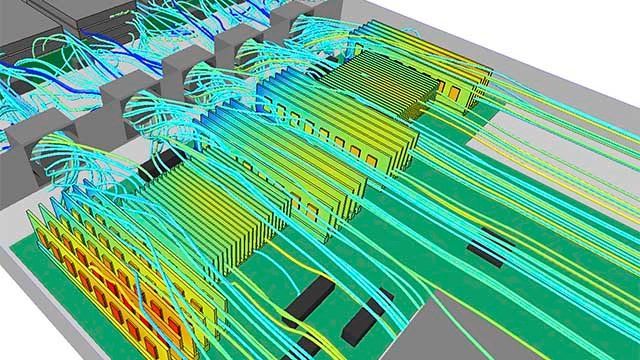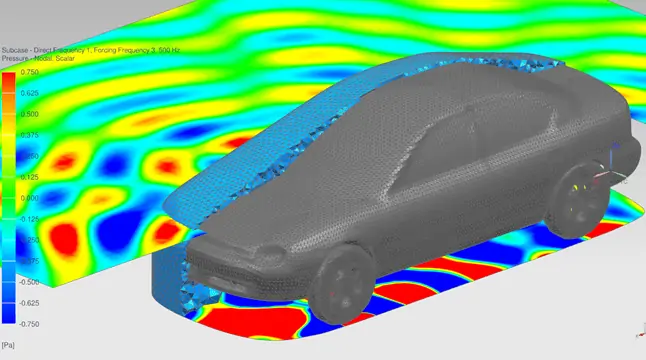The cost of Simcenter Flotherm
When engineers design systems or products that deal with heat transfer, computer simulations can help with an understanding of how and why the temperature changes over time. This is important when precise temperature control and thermal analysis is essential for performance, efficiency, and safety and may require teams to test design modifications on an ongoing basis.

The cost of heat transfer vs. thermal management with Simcenter Flotherm
When engineers design systems or products that deal with heat transfer, computer simulations can help with an understanding of how and why the temperature changes over time. This is important when precise temperature control and thermal analysis is essential for performance, efficiency, and safety and may require teams to test design modifications on an ongoing basis.
With this type of simulation, and by inputting virtual models, engineers can better explore complete systems, predict airflow and run analyses on monitored temperature in physical prototypes. With transient thermostatic control modeling, they can study how the temperature inside a system changes as it runs, considering things like heat origin, release, and how the system behaves. With these modeling capabilities, engineers can see how the temperature responds to different factors like inputs, variations, or the environment.
And, while a broad range of thermal mitigation strategies and monitoring different transient behaviors can seem complex at first, this analysis and thermal design process can be simplified and automated (to an extent) with Simcenter Flotherm software. However, the dangers of heat can mean unexpected costs down the line, in both a financial sense and with regard to safety, product performance, and longevity.
Heat can mean higher costs
There’s a reason that thermal analysis is such a critical part of any engineering design flow before you take a new product to market. In large systems, heat can pose a danger in various ways meaning higher immediate and long-term costs.
Component failure: Too much heat can cause parts to degrade and eventually fail, leading to system malfunctions and expensive repairs to maintain product quality.
Reduced efficiency and reliability: Heat can decrease the efficiency of components and systems, resulting in higher energy consumption and operating costs.
Fire hazard: Improper heat management can create a fire risk, potentially causing damage and safety hazards.
Thermal expansion and contraction: Temperature variations can cause materials to expand and contract, leading to structural stress and potential mechanical failures.
Thermal stress: Heat differentials within a system can create uneven stress, resulting in deformations, fractures, or other damage.
Personnel safety: Heat contact can pose risks to personnel, including burns, heat-related illnesses, and other safety concerns.
To address these dangers, engineers can implement solutions like effective cooling mechanisms, thermal insulation, temperature monitoring systems, and adherence to safety standards. This is where CFD simulation tools like Simenter Flowtherm software can not only increase productivity but also provide valuable data for product safety and development.
Volupes contacts for Simcenter FLOTHERM

An electronics cooling toolbox: Simcenter Flotherm Software
Thermal analysis and model creation is simplified with Simcenter Flotherm software. Import geometries, define boundary conditions and model components with relative ease. Plus, Flotherm uses a unique meshing technology called “SmartParts” that automatically generates an accurate and efficient mesh for complex geometries.
Transient thermostatic control modeling
Transient thermostatic control modeling can be run with the ability to have a model input vary, not only as a function of time, but also optionally as a function of a monitored temperature during the transient solution. This allows you to consider temperature-controlled fans, as well as the determination of power derating and thermal mitigation strategies.
Time-dependent power dissipation analysis
This provides valuable insights and additional information for design engineers to optimize performance, manage heat, design efficient power supply systems, enhance energy efficiency, and ensure reliability and safety in their designs.
Refine the resolution
Refine the resolution or increase the level of detail in certain areas of your model by adjusting the mesh settings to achieve finer resolution in a specific location.
Detailed PCB model creation
With Simcenter Flotherm, you can import PCB geometries, define layers and material properties, place components on the PCB within Flotherm and define the power dissipation between each component, creating a detailed and accurate model.
Post-processing
Flotherm offers various post-processing capabilities to help analyze and interpret the results of thermal simulations, including temperature visualization, heat-flux and component-level analysis, report generation and parametric analysis for evaluating the impact of design variations.
Thermal analysis and design with Simcenter Flotherm software: FAQs
How much does Simcenter Flotherm cost?
The cost of Simcenter Flotherm, a thermal analysis software tool offered by Siemens Digital Industries Software, can vary depending on a number of factors, including the licensing option you choose, the number of user seats required, and the level of support or additional services your organization needs.
Is Simcenter Flotherm used for analyzing IC packages?
A: While Flotherm is primarily focused on thermal analysis and design optimization for electronic systems, it does not specifically deal with the design or analysis of an IC package itself. Instead, Flotherm helps engineers simulate and analyze the thermal behavior of electronic components and systems, including the thermal performance of ICs within their packages.
Why is thermal analysis so important to design engineering teams?
Thermal analysis helps engineers identify and address thermal bottlenecks that limit performance. By simulating airflow and heat transfer, among other behaviors factored into design engineering, teams can create better physical prototypes. This creates more room for addressing critical issues early on and for continuous innovation in managing heat transfer and safety while developing enhanced electronics cooling systems.